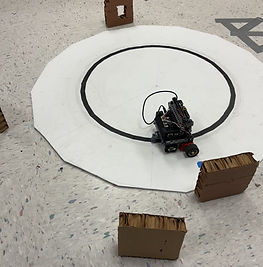
Robot Navigation with Localization & Path Planning
I developed an autonomous robotic navigation system designed to operate in complex, maze-like environments with unknown or partially known layouts. The system focused on adaptive path planning, obstacle avoidance, and real-time localization, using a combination of probabilistic filtering and geometric planning techniques. The robot was tasked with navigating toward a goal while detecting and adjusting to the presence of wooden obstacles, simulating indoor rescue or exploration scenarios.
Implemented in Python using NumPy, SciPy, and Matplotlib, the system fused particle-filter localization with A* path planning to determine optimal trajectories while maintaining an accurate belief of the robot’s position. Ultrasonic sensors were used for distance measurement and obstacle detection, providing real-time updates to the internal map and localization model.
Localization: Detecting Current Positon

-
Trained the robot to determine its current position using particle filtering (probabilistic filtering)
-
This ensures that the robot knows its starting point before calculating the path to the final position
-
Trained the robot on a circular track with cardboard box markers to learn its relative position before deploying it in the maze
A* Path Planning & Maze Navigation

-
Modeled the workspace (physical environment with obstacles) of the robot.
-
Derived the configuration space (C-space) to account for robot dimensions and collision boundaries.
-
Designed and visualized obstacle inflation to ensure paths respected clearance margins.
-
Applied the L2 (Euclidean) distance heuristic to guide the search efficiently while guaranteeing optimality.
-
Implemented the A* path planning algorithm to compute the shortest path from the starting position to the goal
Navigating The Maze

Robot Capabilities:
-
Uses ultrasonic sensors to detect obstacles
-
Determines its position by sensing surrounding obstacles through localization with particle filtering
-
Apply the A* path planning algorithm to compute the shortest collision-free path from start position to the goal
-
Navigates to the goal using the planned path and odometry
*Odometry: The process of estimating a robot’s position by measuring its own movements (e.g., wheel rotations or motion data)